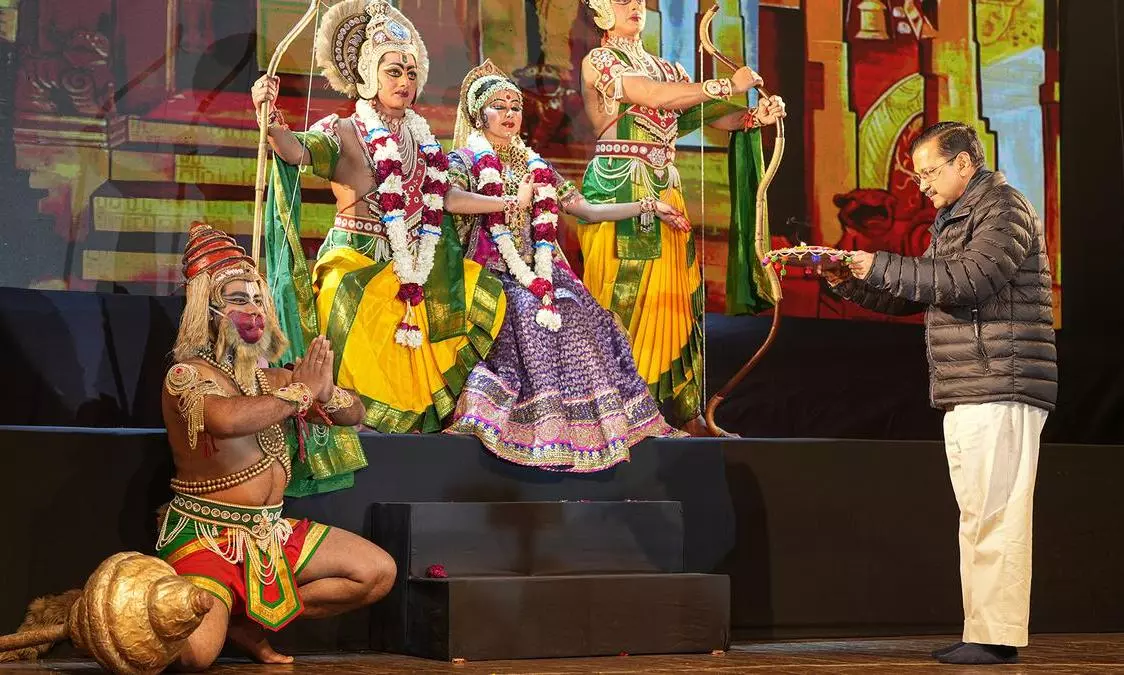
AAP hopes to capitalize on the ‘Ram wave’ to attract Hindu voters
text_fieldsCritics of the Aam Aadmi Party (AAP) often spoke out about the soft Hindutva within the party despite its declared commitment to all people regardless of caste and religion. There were even times when the AAP itself upheld its soft Hindutva.
However, the recent budget presentation at the Delhi Assembly by Finance Minister Atishi was one of the overt attempts by the party to clarify what it stands for against the BJP's hardcore Hindutva.
The Aam Aadmi Party (AAP) government in Delhi presented its annual budget, amounting to Rs 76,000 crore, under the thematic banner of "Ram Rajya." Finance Minister Atishi, during a 90-minute presentation, reiterated the party's commitment to establishing a state reminiscent of Lord Ram's prosperous Ayodhya.
The AAP's strategic embrace of the Hindu narrative appears to be a response to the Bharatiya Janata Party's (BJP) stronghold on Hindu sentiment, especially after the recent inauguration of the Ram Temple in Ayodhya.
Atishi, who took over the finance ministry last year, used the platform to weave references to Ram Rajya and the Ramayana throughout her budgetary discourse. She asserted that the government had been diligently working for nine years to bring prosperity to Delhi akin to the legendary city of Ayodhya.
The Finance Minister even equated former Health Minister Satyendar Jain to Lord Hanuman, drawing parallels between Jain's efforts to revolutionize healthcare in Delhi and Hanuman's legendary feat of bringing the Sanjeevani Booti in a time of crisis.
The AAP's emphasis on "Ram Rajya" did not stop at the budget presentation. The party actively promoted the theme on social media with the hashtag #KejriwalKaRamRajya and employed bow-and-arrow iconography symbolic of Lord Ram across its platforms. The political manoeuvre is seen as an attempt to tap into the "Ram wave" sweeping the nation, particularly after the grandeur surrounding the Ram Temple inauguration.
This soft Hindutva strategy by the AAP is not new. The party has previously engaged in religious events and symbolism, such as organizing Sundarkand paths, Shobha Yatras, aartis, and bhandaras across Delhi on the day of the Ram Temple consecration ceremony in Ayodhya.
The party has also strategically aligned itself with Hindu sentiments in the past, such as building a replica of the Ram Temple before the 2022 Municipal Corporation of Delhi polls and launching the Teerth Yatra scheme before the 2019 Lok Sabha elections.
A senior AAP leader disclosed that the party hopes to capitalize on the "Ram wave" to attract Hindu voters, acknowledging the traditional strength of the BJP in aligning with Hinduism and patriotism. However, critics within the AAP recognize the challenges of appealing to hardcore Hindu voters and suggest that the party still has a long way to go.
The Delhi BJP, on the other hand, has dismissed the AAP's "Ram Rajya-themed Budget" as a mere "cheap publicity stunt" and a "political tactic." Delhi BJP president Virendra Sachdeva criticized the budget, claiming it lacked new development projects and was merely an attempt to gain attention in the run-up to the elections. BJP spokesperson Praveen Shankar Kapoor accused the AAP of panicking in the face of Prime Minister Narendra Modi's political support, particularly after the construction of the Ram Temple.
Despite the AAP's attempt to play the Hindu card, some BJP leaders argue that it will not be sufficient to compete with the emotional resonance of the Ram Temple. They suggest that the AAP's efforts at "appeasement" might result in losing votes rather than gaining ground, emphasizing the distinction between a "Ram Rajya-themed Budget" and the significance of the Ram Temple inauguration.
The Delhi Budget itself outlines key areas of focus, including women empowerment, education, health, and infrastructure. Under the Mukhyamantri Mahila Samman Yojana, the government announced a monthly payment of Rs 1,000 to every adult woman, which Atishi termed as a significant step towards women empowerment. The allocation for the education sector is Rs 16,396 crore, with equal amounts dedicated to health and roads/infrastructure at Rs 8,685 crore each.
The AAP's strategic adoption of "Ram Rajya" in its budgetary discourse and political campaigns underscores its efforts to challenge the BJP's narrative and appeal to Hindu sentiments. Whether this soft Hindutva approach will successfully translate into electoral gains for the AAP in the upcoming Lok Sabha elections remains to be seen.























